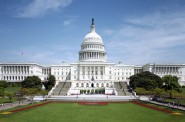Why State Economy Needs Federal Aid
Without second round of pandemic aid there will be more jobs and health insurance lost, more services cut.
The COVID-19 pandemic and resulting recession are wreaking havoc on Wisconsin. The state is likely facing a massive revenue shortfall, which will significantly affect its budget and ability to provide crucial services. If the President and Congress do not provide substantial additional aid, Wisconsin state and local governments will be forced to lay off teachers and other workers, cut important services like health care and education, and take other actions that would make the recession longer and more painful. These budget cuts would fall most heavily on low-income and minority families, who have already been hit the hardest by the pandemic and the recession.
States need to keep money flowing through communities to help the economy recover. But the pandemic forced the closure of a lot of economic activity, which resulted in huge job losses and correspondingly less revenue to pay for critical services that help communities thrive economically. In May, Wisconsin had an unemployment rate of 12 percent, one of the highest rates ever recorded, with roughly 375,000 more state residents without jobs compared to February. Approximately 720,000 Wisconsinites, representing 23 percent of the state’s February labor force, have filed unemployment insurance claims since the beginning of March.
Wisconsin has not yet released information on projected shortfalls for the state budget, but every state that has released COVID-19-related budget data has noted significant shortfalls for the next several years. The shortfall will create a severe funding crisis for schools, health care, and other critical services. Cities in Wisconsin are facing serious revenue shortfalls as well. Milwaukee County alone has recently projected a budget shortfall of $450 million. Studies on the Great Recession have found that forcing state and local governments to deal with severe budget constraints through austerity dampens long-term economic growth, prolongs spells of high unemployment and extends recessions.
Health care in Wisconsin is also in jeopardy. Medicaid caseloads could increase by as much as 291,000, or 30 percent, through next year, a massive and unprecedented spike. Wisconsin desperately needs help to cover those who are newly unemployed and expected to enroll in Medicaid and offset extra Medicaid costs related to coronavirus. Without proper funding, the state will be unable to treat at-risk patients, keep families healthy, or provide life-saving care. Funding Medicaid is critical to ensuring that Wisconsin can respond effectively to the coronavirus public health crisis and the current economic recession.
The Health and Economic Recovery Omnibus Emergency Solutions (HEROES) Act, which passed the House of Representatives on May 15 with bipartisan support, includes provisions that would help Wisconsin avoid additional layoffs and devastating cuts to services. Specifically, it would:
- Allocate $8.5 billion to the state and $7.5 billion to local governments in Wisconsin over the span of two years, which would save thousands of jobs, and help maintain the uninterrupted delivery of public services like health care, first responders, and safe drinking water.
- Increase Wisconsin’s Federal Medical Assistance Percentage (FMAP) and provide an additional $1.9 billion in Medicaid dollars to Wisconsin over an 18 month period.
- Provide $1.4 billion for education in Wisconsin, including $915 million for public K-12 schools and $422 million to public colleges and universities, which would save 10,000 jobs supporting K-12 education and 2,800 supporting higher education. This funding would help strengthen distance learning and teaching strategies to keep students and teachers healthy.
As the recession stretches into the second half of 2020, it is becoming increasingly clear that states and local governments are at the forefront of combating the pandemic and its economic fallout. From keeping students enrolled in remote learning programs to equipping community health centers with the protective gear needed to safely treat COVID-19 patients, state and local involvement can be seen and felt everywhere. But without federal help those efforts will fall far short.
More about the Coronavirus Pandemic
- Governors Tony Evers, JB Pritzker, Tim Walz, and Gretchen Whitmer Issue a Joint Statement Concerning Reports that Donald Trump Gave Russian Dictator Putin American COVID-19 Supplies - Gov. Tony Evers - Oct 11th, 2024
- MHD Release: Milwaukee Health Department Launches COVID-19 Wastewater Testing Dashboard - City of Milwaukee Health Department - Jan 23rd, 2024
- Milwaukee County Announces New Policies Related to COVID-19 Pandemic - County Executive David Crowley - May 9th, 2023
- DHS Details End of Emergency COVID-19 Response - Wisconsin Department of Health Services - Apr 26th, 2023
- Milwaukee Health Department Announces Upcoming Changes to COVID-19 Services - City of Milwaukee Health Department - Mar 17th, 2023
- Fitzgerald Applauds Passage of COVID-19 Origin Act - U.S. Rep. Scott Fitzgerald - Mar 10th, 2023
- DHS Expands Free COVID-19 Testing Program - Wisconsin Department of Health Services - Feb 10th, 2023
- MKE County: COVID-19 Hospitalizations Rising - Graham Kilmer - Jan 16th, 2023
- Not Enough Getting Bivalent Booster Shots, State Health Officials Warn - Gaby Vinick - Dec 26th, 2022
- Nearly All Wisconsinites Age 6 Months and Older Now Eligible for Updated COVID-19 Vaccine - Wisconsin Department of Health Services - Dec 15th, 2022
Read more about Coronavirus Pandemic here
Wisconsin Budget
-
Charting The Racial Disparities In State’s Prisons
 Nov 28th, 2021 by Tamarine Cornelius
Nov 28th, 2021 by Tamarine Cornelius
-
State’s $1 Billion Tax Cut Leaves Out 49% of Taxpayers
 Sep 21st, 2021 by Tamarine Cornelius
Sep 21st, 2021 by Tamarine Cornelius
-
TANF Program Serves a Fraction of Poor Families
 Aug 30th, 2021 by Jon Peacock
Aug 30th, 2021 by Jon Peacock






















